Scott Hamilton – 12 August, 2016
But Nikau Hindin doesn't want to make ngatu. She is trying to resurrect a Maori tradition of tapa making that had already perished by the time Cook reached Aotearoa. Hindin only learned about Maori tapa in 2011, when she was studying in Hawai'i. One of her instructors explained that Maori had called the paper mulberry tree aute, and pointed her towards the texts of the late anthropologist Roger Neich.
Last month I spent a few days in the Kingdom of Tonga. I lay in a hammock in Ngele’ia, one of the village-suburbs of Nuku’alofa, the kingdom’s capital and only town, and listened to the beats that floated through coconut groves and over iron fences towards me.
On every day except the Sabbath, groups of Nuku’alofan women sit in sheds called fale koka’anga, and hit wet bark with wooden clubs. The bark has been prised from the tree that Tongans call hiapo and palangi call paper mulberry, then pinned for weeks under coral stones in lagoonwater. The women hit the soaked bark until it is soft, then paint it with symbols and signs - a row of Norfolk pines, a crucifix, a crown, a peculiar, dog-like lion native to Tongan art - then stretch it in the sun to dry. (1) The painted barkcloth is known as ngatu, and offered as a me’a’ofa, or gift, at weddings and twenty-first birthday parties and funerals.
Tongan women like to talk while they beat, and fale koka’anga are places for plotting and gossiping and retelling old stories. Most Tongan villages have several of the buildings, and their occupants are reputedly able to communicate with each other in a percussive code, passing on news and warnings and jokes. From my Ngele’ia hammock I thought I could hear the beating of dozens of women in three or perhaps four fale koka’anga.
A couple of days after I returned from Tonga to Nu’u Sila I rode through a hailstorm to Nathan Homestead, a lurching colonial mansion set amidst dripping ornamental gardens on the posh, Pakeha side of Manurewa. On the screen in a cold room on the homestead’s second floor a young woman had picked up a tapa beater. She moved the beater about in her hand, took a tentative grip, and began to tap on a thin strip of bark. She tapped lightly and slowly, as though she were worried that the beater might break, or that the strip of bark might split. The young woman worked alone, on the wall of the deserted room.
If she had wanted them, Nikau Hindin could have had local teachers. A short way from Nathan Homestead, in a new railway station that doubles as an outlier of the Manukau Institute of Technology campus, two enormous ngatu were recently hung on the wall and blessed. The ngatu were designed by Benjamin Work, Leilani Kake, and Mary Ama, and painted by thirteen female members of the Dominion Road Tongan Methodist church. In Auckland’s Tongan community skillful and prolific barkcloth artists are continually at work. (2)
But Nikau Hindin doesn’t want to make ngatu. She is trying to resurrect a Maori tradition of tapa making that had already perished by the time Cook reached Aotearoa. Hindin only learned about Maori tapa in 2011, when she was studying in Hawai’i. One of her instructors explained that Maori had called the paper mulberry tree aute, and pointed her towards the texts of the late anthropologist Roger Neich.
Neich spent decades in the Auckland War Memorial Museum’s basements and backrooms, unwrapping and describing masks and statues and paintings that had suffered insults and defacement from palangi missionaries and Christianised chiefs. Neich’s research was a mixture of retrieval and speculation. Just as the best paleontologist is able to reimagine an entire species of dinosaur after unearthing a couple of fragments of a shin bone, so Neich could dig a mask or a flute out of a swamp or museum storage room and make inferences about the structures and values of the society that produced the object.
Aute trees grow imperfectly in New Zealand’s cold weather, and although Cook and his crew noticed the odd tapa ornament hanging from the ear of a rangatira they never saw a Maori tapa mat. The aute species had been killed by grazing cattle and neglect by 1840, but fourteen aute beaters survived, in the amniotic fluids of swamps and tidal creeks. (3) Neich examined them, noting the vertical and diagonal carvings Maori had made with pipi shells on some of their handles, and the various shapes of their heads. He corralled and interrogated the descriptions of aute and tapa left by Cook and other early interlopers in Aotearoa, and he listened with his usual unobtrusiveness to the stories that linger on some marae. Then Neich compressed all his research into a short chapter in Pacific Tapa, a book he co-authored with Mick Pendergast.
Hindin is not the first artist to drink from Neich’s texts. His massive and meticulous book about the meeting house paintings of Te Kooti’s followers inspired the young Shane Cotton, and his study of the carved goddesses of Tonga has fascinated Visesio Siasau.
When she returned from Hawai’i to Auckland, Nikau Hindin remembered a local aute that Dante Bonica had shown her. Bonica is a master carver who runs workshops in traditional Maori artisanship at Waipapa marae. Hindin called on Bonica, and the two of them revisited the precious tree. Hindin tried to strip its flesh with her fingers, but soon found that her teeth were more efficient. As she weighed the scrolls of bark on her tongue, Hindin exulted. She was, she believed, the first Maori to taste aute in five hundred years. Hindin soaked the bark in water, then wielded some of the beaters she had modelled on Neich’s artefacts.
As soon she could bite and beat the aute with confidence, Hindin began to organise friends and family members into a ‘wananga aute’. One day last November she and her collaborators beat and painted tapa in central Auckland’s Aotea Square.
*
Hindin’s exhibition at the Nathan Homestead extends through two rooms. There are two screens, two painted sails, half a dozen painted tapa cloths, and a canvas painting on the walls; a long table is laden with beaters, shells, and the outsized notebook where Hindin has logged, with a mixture of drawings and diagrams and ebullient prose, her research into aute.
On one of the walls of the Nathan Homestead gallery Hindin shows off half a dozen painted barkcloths, fruits of her wananga aute. Credited collectively to the wananga, the narrow strips of tapa are decorated with dots, diagonal lines, triangles. If the vast ngatu that Tonga’s fale koka’anga continually produce are like barkcloth Bibles, collecting sacred forms and symbols, then the tapa Hindin displays are like the Dead Sea Scrolls: fragmentary and enigmatic. They are frustrating, because they make us want to see more, and exhilarating, because they suggest what might have once existed, and what might be brought to light now.
Two sails hang on another wall. They once helped the Hokule’a, a vessel created by the Hawai’ian academic and adventurer Ben Finney, cross the Pacific. Upset by amateur historian Andrew Sharp’s influential 1956 book Ancient Voyagers in the Pacific, which suggested that storms and misadventure, not star maps and sail power, had taken Polynesians from island to island through the Pacific, the young Finney decided to reenact the past. Built with traditional materials and devoid of a compass, let alone GPS, the Hokule’a sailed from Hawai’i to Tahiti in 1976, and has since travelled through much of Polynesia and Micronesia. By sailing his vaka so far and so safely, Finney has sunk Sharp’s ‘drift theory’ of Polynesian exploration. Hindin has painted lines over the Hokule’a‘s sails: they record the ship’s journeys, and map the Pacific sky’s archipelagos of stars. (3)
*
In a note accompanying her exhibition, Nikau Hindin explains that making tapa is a way for her to ‘reconnect’ with her tipuna. Hindin’s project reminds us that her tipuna include not just the ancient inhabitants of Aotearoa but the dozens of other peoples of Polynesia, who brought seeds and beaters to island after island during their three thousand year colonisation of the Pacific. Like Lisa Reihana’s in pursuit of Venus (infected), which sets incidents from the history of Tahiti and Aotearoa in the same archetypal Pacific landscape, Hindin’s work melts the distinction between temperate and tropical Polynesia.
And the resonances of Hindin’s exhibition extend beyond Polynesia. The Hokule’a may have been constructed in Polynesia, but its first navigator was Mau Piailug, from the atoll of Satawal in the Federated States of Micronesia. Unable to find a Polynesian trained in the old art of sailing by the stars, and knowing that traditional Micronesian and Polynesian aquatechnology and navigation were very similar, Finney recruited Piailug. With Finney’s encouragement, Piailug reintroduced Polynesians to the techniques their ancestors had known, before inter-island vaka journeying was stymied by colonial borders and steamships and aeroplanes.
Like star-based navigation, tapa is an artform that extends far beyond the liquid borders of Polynesia. Some of the remote ancestors of Maori on aboriginal Taiwan painted on barkcloth.
*
Hindin’s tapa pose questions about authenticity. Can one person begin the revival of a collective practice that has been in abeyance, in these islands at least, for centuries? What would Roger Neich have made of Hindin’s project? Are the texts of salvage anthropologists like Neich tombstones raised respectfully over dead practices, or are they more like the mysterious vats in which cryogenic scientists preserve bodies that might one day be revived?
Hindin is not like the kapa haka dancer or carver or tattooist, who can learn from living practitioners of their arts and feel part of continuous traditions. Her project has some similarities with the work of Richard Nunns and the late Hirini Melbourne, who built replicas of the ancient and rare putorino they found in museums and taught themselves to play the instruments.
There are similarities, too, with the work of Moriori activists. In the century and a half after the invasions of their homeland in 1835, Moriori saw their culture drastically attenuated. Their language was repressed, and the meanings of the famous carvings that cover the kopi trees of their islands became obscure.
Moriori scholars like Maui Solomon and Susan Thorpe have sometimes had to pluck practices and symbols from the texts of long-dead Pakeha and Maori ethnographers. The Moriori cultural renaissance is informed by the past, but it is also a creative labour. With its shape taken from the beloved albatross and its central pou covered with dendroglyphic inscriptions, the marae that Moriori have raised at Kopinga, near the windy northeast edge of Chatham Island, is an awesome mixture of reconstruction and imagination.
It is poignant to watch the video that shows Hindin working alone on her tapa, mentored only by ethnographic texts and museum artefacts. But Hindin’s loneliness has also given her a freedom that is not always available to barkcloth painters. I wrote recently for EyeContact about Tanya Edwards, who laments the way that many Tongan women feel obliged to use a few institutionalized patterns and symbols when they paint ngatu. Edwards has disobeyed the demand that she paint Norfolk pines and crosses and crowns, and taken to putting coke bottles and cans of corned beef on her barkcloths. (4)
When he exhibited his ngatu for the first time in 2013, Visesio Siasau was told by some of his own relatives that he had had no right to paint them, let alone display them. As a man, he ought to have stayed out of the fale koka’anga. Religious conservatives have been upset by Siasau’s ngatu portrait of Jesus marked with a dollar sign, even though this portrait helped win him the Wallace Award in Nu’u Sila. (5)
Hindin has worked hard to honour her tapa-making tipuna. She has carved her beaters from kauri and totara, and given them the same markings and shapes as extant beaters. She has upheld the communal character of ancient Maori tapa making by founding her wananga aute.
Because the Maori tapa making tradition is so attenuated, though, Hindin does not have to contend with the proscriptions and criticisms familiar to Edwards and Siasau. Few Tongan males would follow Siasau into the fale koka’anga, but Hindin has recruited both genders for her wananga. Since nobody is sure what Maori painted on tapa, nobody can charge Hindin with using an unfaithful motif or symbol.
The philosopher Stephen Davies has argued that the performance of a traditional artform can only be authentic if it is innovative. Instead of seeking simply to repeat a Beethoven symphony an orchestra must reinterpret, and therefore reinvent, the piece; instead of merely copying their masters, apprentice carvers ought to add their own inflections and deformities to their blocks of wood and stone. If we accept Davies’ argument, then the speculative, innovative tapa of Nikau Hindin and her wananga might be considered more authentically traditional than some of the hackneyed ngatu that Tanya Edwards and Visesio Siasau have criticised.
*
Hindin’s tapa also raise a question about the emergence of Maori culture in these islands. In an entry on a blog she set up to document her research into aute, Hindin suggests that Maori tapa would have been made ‘very early on’ in the human history of these islands, when ‘people first settled’ here. (6)
The few surviving aute beaters are surprisingly different from one other. (7) Some have squared while others have triangular cross-sections. Some are carved; others are unmarked. Roger Neich notes that the Maori artefacts are more heterogenous than their counterparts in Tahiti and the Cooks and the Marquesas. He suggests that different East Polynesian peoples might have settled Aotearoa at different times, bringing their distinctive beaters with them.
Neich’s argument rhymes with the research of Roy Harlow, a linguist who listens to early recordings of Maori orators and singers. These recordings were made before urbanization softened the differences between the dialects of te reo Maori, and Harlow believes that they offer clues to the earliest history of Aotearoa.
In his essay ‘Maori Dialectology and the Settlement of New Zealand’ Harlow links some of the sounds of te reo o Kai Tahu to the Marquesas archipelago, connects Mangaian with the dialects of the western regions of Te Ika a Maui, and detects a Rarotongan influence on te reo o Ngati Porou. Like Neich, Harlow thinks that Aotearoa may have been settled by several different groups of East Polynesians, whose cultures eventually coalesced and developed into what we understand today as Maori. (7)
*
Because it implies so many questions about the past and about the identities we draw from the past, Nikau Hindin’s attempt to revive Maori tapa has a surprising relevance to contemporary political debate.
Last year I watched the film maker Paul Janman interview Justin Taua, the veteran trade union and Maori land rights activist. Taua lives in Ngaruawahia, a few metres down the road from King Tuheitia, but he is a critic of what he calls the ‘Maori elite’.
Taua explained to Janman that Tainui and a number of other cashed-up iwi have invested in businesses that exploit Pacific Island and Southeast Asian labour. Some iwi have made money from fishing ships that paid almost nothing to crews recruited in the tropical Pacific.
Taua drew a line between dodgy iwi businesses and the isolationist worldview promoted inside some iwi. He remembered standing up on marae to talk about the lot of Third World workers or wars in the Middle East, only to be told that he should be sticking to properly ‘Maori’ subjects. But Taua regarded such advice with contempt:
I am Maori, but before my ancestors were Maori they were already Polynesian, and before that they lived in Southeast Asia. We can go all the way back, to Taiwan, to the Asian mainland. That’s all part of my whakapapa. I am an internationalist because I am Maori and I understand my history. But the message from some of the Maori capitalists is that Maoridom is a thing apart, that we don’t have relatives outside Aotearoa, and so we don’t have to care about how we treat Pacific Islanders and Asians that work for us… (8)
Taua’s internationalism makes him a critic of New Zealand governments and redneck Pakeha as well as iwi corporations. He opposes immigration policies that keep many Pacific Islanders out of New Zealand, pointing out that these islanders are related to the people who discovered and settled New Zealand. He mocks rednecks who treat Southeast Asians living in New Zealand as aliens, when these peoples have far stronger connections with the South Pacific than Europeans.
I think Justin Taua would appreciate Nikau Hindin’s work. Like Reihana’s Venus, Hindin’s tapa are a corrective to static and isolationist ways of thinking about the past. By reconnecting with her ancestors, Hindin also links Aotearoa to a broader world.
Scott Hamilton
(1) I have written for EyeContact about Tui Emma Gillies’ attempts to stalk and paint the mysterious Tongan laione: http://eyecontactsite.com/2014/03/tui-emma-gillies-and-the-lions-of-tonga
(2) The ngatu hanging in MIT’s Manukau campus were made with the support of Kolokesa Mahina-Tuai, the associate Pacific curator at Auckland’s War Memorial Museum and an expert on and advocate for barkcloth art. I blogged about Mahina-Tuai’s attempt to change the way palangi New Zealanders see ngatu and other ‘traditional’ Pacific artforms at: http://readingthemaps.blogspot.co.nz/2014/07/occupying-not-abandoning-bourgeois.html
The women who painted the ngatu for MIT call themselves the Fauniteni ‘oe Mo’ui Collective.
(3) The Hokule’a is a nineteenth metre long doubled hulled vaka. Art historian Herb Kane and aquatechnologist Terry Holmes helped Ben Finney design the boat. The Hokule’a’s journey took thirty-four days, and was celebrated by a crowd of Tahitians. The Hokule’a landed in Aotearoa in December 1985, after a journey of sixteen and a half days from Rarotonga. The vessel is currently on a round-the-world voyage that is expected to last four years.
(4) http://eyecontactsite.com/2016/06/art-in-a-weimar-kingdom
(5) Visesio Siasau exhibited his first ngatu in September 2013, when he took part in a show staged by No’o Fakataha, the collective of Auckland-based Tongan artists, at Nuku’alofa’s ‘Atenisi Institute. No’o Fakataha’s Tongan adventure was organised with the help of Sisi’uno Helu, the director of ‘Atenisi and the daughter of the institute’s late and legendary founder, Futa Helu. While most of No’o Fakataha’s members flew from Auckland for the exhibition, Visesio Siasau had been living in Nuku’alofa for much of 2013, and had turned the verandah of his parents’ fale in the village-suburb of Haveluloto into a makeshift studio. Although many members of his family had seen the ngatu he had stretched out to dry on the verandah, some still felt shock and anger when they saw his work on the walls of ‘Atenisi. I blogged earlier this year about the opposition Siasau’s work has sometimes faced from religious conservatives: http://readingthemaps.blogspot.co.nz/2016/03/pluralism-and-paganism.html
(6) Nikau Hindin’s blog can be read at http://kapatotapa.tumblr.com During his 1769 visit to Te Ika a Maui Cook was shown a small plantation of aute, but Hindin believes, on the basis of her reading of Neich and her own research, that the small tapa ornaments Cook observed on a few high-ranking Maori were made long before the eighteenth century. Perhaps the antiquity and rareness of tapa had helped make it a taonga.
(7) All the surviving aute beaters have been found in the northern regions of Te Ika a Maui. Several have emerged from the muddy rivers that feed the Kaipara harbour.
(8) Harlow’s essay was published in The Origins of the First New Zealanders, edited by Doug Sutton, Auckland University Press, 1994, pgs 106-122.
(9) Paul Janman and I were hosted by Justin Taua and his partner Jean Ayre during the Ngaruawahia part of our walk up the Great South Road last December. Taua defines himself politically as a Trotskyist, and has been a delegate for the National Distribution Union, a prominent and popular member of the movements against the wars on Afghanistan and Iraq, a participant in occupations and hikoi demanding the return of alienated Maori land, and the author of reports and polemics for the Auckland-based magazine Class Struggle. An archive of articles from Class Struggle can be found at: http://redrave.blogspot.co.nz/ I discussed some of Taua’s recent work in Ngaruawahia in the interview Janman and I did with Radio New Zealand after we finished our walk: http://www.radionz.co.nz/national/programmes/standing-room-only/audio/201783582/the-great-south-road-revisited
Recent Comments
Scott Hamilton
Sorry: there are a few typos in that hasty comment! I meant to refer to aute beaters, and not aute ...
Scott Hamilton
Thanks for your comment Richard. When I told friends about Nikau Hindin's exhibition, a lot of them thought I was ...
Richard Taylor
This is very interesting. For some reason I thought Maori art always had tapa of some sort. I must have ...
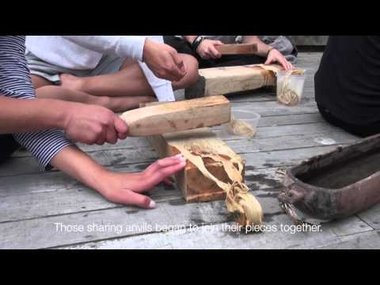
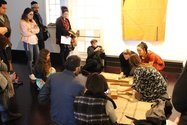
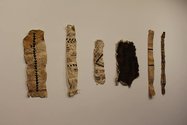


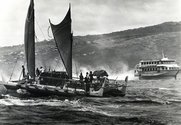
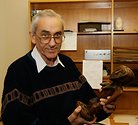
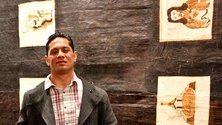
 Advertising in this column
Advertising in this column Two Rooms presents a program of residencies and projects
Two Rooms presents a program of residencies and projects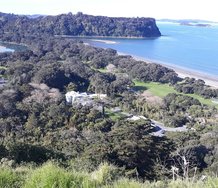
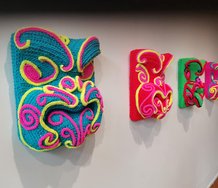

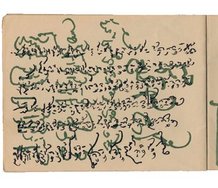
This Discussion has 3 comments.
Comment
Richard Taylor, 12:18 a.m. 13 August, 2016 #
This is very interesting. For some reason I thought Maori art always had tapa of some sort. I must have been thinking of the designs you talked about re those of Te Kooti and the art that emerged.
Did Paul Davies write that re Beethoven as such? I went to lectures on The Philosophy of Art by him in 1994. The idea he mooted was more or less as a question (among others that were raised in an interesting book:'Puzzles About Art').
The wider cultural connections are interesting and the links to Moriori and the more 'heterogeneous nature' of Maori art and the wider outlook of Justin Taua, Edwards and Visesio Siasau. The question re the Beethoven Symphony was something like: if some one found another Beethoven Symphony - or composed one in the style of Beethoven and it was as good as his (ie. Beethoven's) music - would it have the same significance, and impact, and in fact would it be 'in the tradition'?
And of course to compose like Beethoven now is clearly pretty redundant! (I feel.)
I'll make a quick irrelevance here: the Concert Program (especially one of their presenters who actually criticized the innovative work of Schnittke, seeming to prefer only old music) keeps recycling the music of Beethoven Mozart Schubert and with some exceptions, mostly non-twentieth century music - although there is quite a lot of NZ music - but the percentage should be reversed: the tradition is that music and art continue to develop, so we should be hearing 80% of from Webern, Schoenberg, Ives to the mid 20th Century composers and to the "now" of composers currently writing. But no, it is hugely the old things I have heard for years: except on Friday nights which is more innovative music...
So there is an example where Pakeha and Palangi are also - like the conservatives or others in Tonga etc who want to keep to traditional forms only - just as conservative. The point about the Beethoven I think was that it might have to be performed in a new way to get the effect of newness it had when say the 5th Symphony was first played. The impact was enormous. But now that has faded. Then came Stravinsky's Rite of Spring - first put on in 1913. It and the dancing caused a riot. So if there is opposition it is a sign that something vital and innovative is being made.
Similarly with (among others in Tonga and other parts of the Pacific) the new art of Nikau Hindin.
All good, EXCEPT, you blogged about this and the whole exhibition was well over. Bit hard for me to see the exhibition now!
Scott Hamilton, 1 p.m. 19 August, 2016 #
Thanks for your comment Richard. When I told friends about Nikau Hindin's exhibition, a lot of them thought I was having on. Even when I showed them the promo material for the show, I suspect that they thought it might be some sort of 'Forgotten Silver'-style hoax. The notion of Maori tapa confuses many of our categories, it seems.
Coincidentally, I was reading David Simmons' fascinating book Greater Maori Auckland this weekend, and I found a chapter called Lost Lands, about the flat and sandy islands that once existed off Awhitu and in the Kaipara harbour, but which were slowly consumed by wind and water, and no exist only in a melancholy photograph and in some oral traditions. Simmons says that the lost land of Taporapora, which is today no more than a mangrove bank off a tiny bach village at the end of a peninsula in the central Kaipara, was once the home of a whare wananga and of a famous plantation of aute. It was interesting to learn this story, because several aute have been found close to Taporapora, in the mudchoked mouth of the rivers that feed the Kaipara harbour. Oral tradition and archaeology seem, then, to be supporting one another.
And I wonder whether we couldn't also bring palaeoclimatology to the table, and ask whether a microclimate helpful to the raising of tropical plants like aute might have existed at Taporapora half a millennium or so ago. Microclimates certainly exist in the Kaipara region today: olives and other Mediterranean crops are grown on the Tinopai peninsula, which extends into the harbour from the north, and is known for its warm and dry weather.
On a slightly different subject: Stephen Davies is a musician for many years taught a paper in the Philosophy of Art at the University of Auckland, where he liked to discuss his ideas about authentic performance. I might be stretching his arguments, by making them cover a 'craft' tradition like tapa, but I don't like the idea of a stringent border between craft and art.
Scott Hamilton, 1:46 p.m. 19 August, 2016 #
Sorry: there are a few typos in that hasty comment! I meant to refer to aute beaters, and not aute themselves, being found in the muddy rivers of the Kaipara. The late great Roger Neich wrote this report on the most recent beater to turn up in the Kaipara: https://www.jstor.org/stable/42905854?seq=1#page_scan_tab_contents
Participate
Register to Participate.
Sign in
Sign in to an existing account.